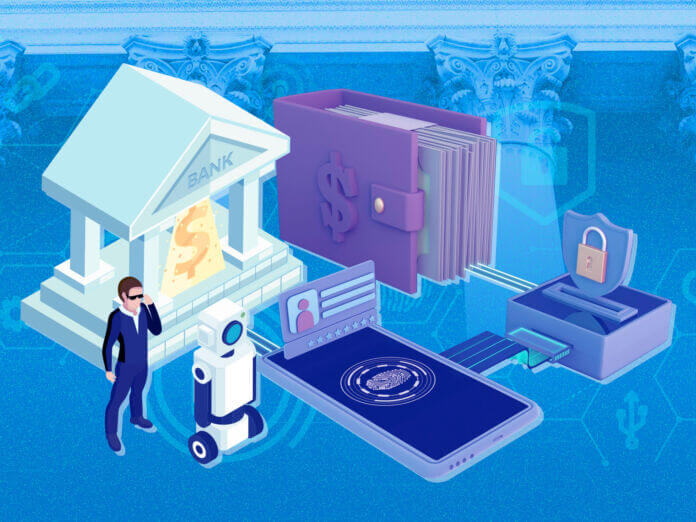
The current banking security landscape involves increasing threats from physical and digital sources, with cyberattacks, fraud, and unauthorized access posing significant risks. Robust security measures are crucial to protect sensitive financial data, maintain customer trust, and comply with regulatory requirements.
With their advanced capabilities in real-time monitoring, data analysis, and automated response, the Internet of Things (IoT) devices offer immense potential.
The Role of IoT in Banking
IoT devices in banking refer to interconnected gadgets — like smart cameras, biometric sensors, and environmental monitors — that enhance security through real-time data collection and analysis. In 2022, the finance and insurance sector utilized over 82 million IoT-connected devices, reflecting the growing adoption of this technology.
These technologies integrate seamlessly with existing security systems and provide advanced functionalities such as automated threat detection and instant alerts. Banks can leverage IoT to fortify their security infrastructure and ensure comprehensive protection against physical breaches and cyber threats.
Enhancing Physical Security with IoT
Improving physical security in banks is crucial to safeguarding assets and ensuring the safety of customers and employees. IoT devices are pivotal in this scenario, as they offer advanced surveillance, access control, and environmental monitoring solutions.
Smart Surveillance Cameras
Real-time monitoring and advanced analytics from IoT devices revolutionize bank security by offering continuous surveillance and intelligent data processing. Smart cameras with IoT technology can detect unusual activities and send instant alerts to security personnel, enabling swift responses to potential threats.
Additionally, advanced analytics help analyze patterns and behaviors to identify suspicious activities before they escalate into security breaches. This proactive approach ensures higher security and peace of mind for banks and their customers.
Access Control Systems
Biometric sensors and smart locks significantly enhance bank security by restricting access to authorized personnel only. With over 1,600 federal bank robberies in the U.S. in 2022, these advanced technologies are essential to prevent unauthorized entry and protect valuable assets.
Fingerprint and facial recognition systems ensure that only verified individuals can access sensitive areas. Smart locks provide an additional layer of security by allowing remote control and monitoring of entry points. This combination of IoT technologies helps banks maintain a secure environment and reduce the risk of physical intrusion.
Environmental Sensors
Monitoring physical conditions with IoT devices prevents unauthorized access and potential damage in banks. Environmental sensors can detect temperature, humidity, and motion changes, and alert security teams to anomalies that might indicate a security breach or environmental hazard.
These sensors help safeguard critical areas like vaults and data centers by ensuring optimal conditions and preventing tampering. Integrating these IoT solutions allows banks to maintain a secure and stable environment and reduce the risk of intentional and accidental damage.
Boosting Digital Security with IoT
In the digital age, protecting sensitive financial data is paramount. IoT devices enhance digital security by providing various benefits, making banks more resilient to cyberattacks.
Data Protection
IoT devices are essential in encryption and secure data transmission because they ensure sensitive financial data remains protected. Banks typically require a username, password, and multifactor authentication to confirm a user’s identity in an app. IoT devices enhance these security measures by providing additional encryption and secure communication channels.
They help safeguard data during transmission, making it difficult for cybercriminals to intercept or tamper with the information. Integrating IoT technology ensures banks’ digital interactions remain secure and their customers’ data is safe.
Network Security
IoT-enabled firewalls and intrusion detection systems are vital components in enhancing banks’ digital security. These advanced systems continuously monitor network traffic, identifying and blocking potential threats in real-time. Leveraging IoT technology lets these firewalls quickly adapt to emerging cyber threats and ensure robust protection against unauthorized access and cyberattacks.
Intrusion detection systems use IoT sensors to analyze network activity, detecting unusual patterns that may indicate a breach. This proactive approach enables banks to respond swiftly to security incidents, minimize risks, and ensure the integrity of their digital infrastructure.
Real-Time Threat Detection
Using IoT for continuous monitoring and response is essential for addressing fraud prevention — a significant concern for financial institutions of any size. IoT devices provide real-time surveillance and analysis, enabling banks to detect and respond instantly to suspicious activities.
These systems can monitor transactions, identify unusual patterns, and trigger alerts for potential fraud. This continuous oversight helps financial institutions mitigate risks and protect their assets and customers. Integrating IoT allows them to enhance their fraud prevention strategies and ensure a secure and trustworthy environment for financial operations.
Challenges and Considerations
While IoT devices offer significant security benefits, they also introduce potential risks, as evidenced by over 112 million IoT cyberattacks worldwide in 2022. These devices can create new vulnerabilities, making it crucial for banks to address potential security gaps.
Integration challenges with existing security infrastructure can complicate the deployment of IoT solutions and can require careful planning and execution.
Additionally, organizations must address regulatory and compliance considerations to ensure IoT implementations adhere to financial industry standards and protect sensitive data. Acknowledging and managing these challenges can effectively harness the power of IoT while maintaining robust security and compliance.
The Critical Role of IoT in Enhancing Bank Security
Adopting IoT for comprehensive security is crucial for banks to stay ahead of evolving threats and protect their assets effectively. These firms must explore IoT solutions to enhance security measures and ensure a safer environment for their operations and customers.
- SEO Powered Content & PR Distribution. Get Amplified Today.
- PlatoData.Network Vertical Generative Ai. Empower Yourself. Access Here.
- PlatoAiStream. Web3 Intelligence. Knowledge Amplified. Access Here.
- PlatoESG. Carbon, CleanTech, Energy, Environment, Solar, Waste Management. Access Here.
- PlatoHealth. Biotech and Clinical Trials Intelligence. Access Here.
- Source: https://www.iotforall.com/how-iot-improves-bank-security



